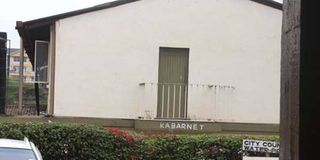Tragic school fire raises critical questions on safety

A dormitory named Kabarnet at Moi Girls School, Nairobi that burnt down on September 2, 2017 leaving nine students dead. PHOTO | JEFF ANGOTE | NATION MEDIA GROUP
What you need to know:
The loss of the innocent lives rekindles sad memories of fire tragedies that have rocked the education sector in the recent past, with 126 cases in 2016 going down into history.
Other findings cited drug abuse and imposition of strict rules on students by school administrators.
That politicisation of school leadership can lead to arson attacks should be a cause of great worry to all stakeholders in the education sector.
The revelation by Education Cabinet Secretary Fred Matiang’i that the recent fire at Moi Girls High School in Nairobi that claimed the lives of nine girls was a case of arson raises more questions than answers.
Dr Matiang’i observed: “We have a school environment where there are arguments about local communities and the headteachers and they foolishly take it on to the point of destroying school property and getting into criminal activities to make a point.”
He added that some parents are angered that the job of headteacher goes to those who “don’t come from the area or from the same clan”.
“We cannot resolve a conflict in a school or a conflict on the headship of a school, by burning the school,” he said.
The loss of the innocent lives rekindles sad memories of fire tragedies that have rocked the education sector in the recent past, with 126 cases in 2016 going down into history.
MOTIVES
At the time, a variety of motives were cited; some included what appeared to be protests by students over the shortening of holidays and limiting of visits by parents.
Others included revenge from cartels that had previously benefited from selling of national exam papers prior to the exams.
The cartels were fighting back due to the strict supervision and distribution measures that had been put in place to secure the integrity of examinations.
Blame was also placed on parents who failed to discipline their children.
Dr Fred Matiang’i castigated parents for failing to “instil the right values” which, in turn, resulted in students engaging in anti-social behaviour.
GUIDENCE
Teachers were also said to lack guidance on how to manage students’ behaviour, especially after the government banned caning in schools without putting in place alternative and workable ways of handling students’ indiscipline. Other findings cited drug abuse and imposition of strict rules on students by school administrators.
That politicisation of school leadership can lead to arson attacks should be a cause of great worry to all stakeholders in the education sector.
Management wrangles, clan politics and questions of who should sit in school boards have dogged many schools over time to the extent of bringing even giant schools to their knees.
In a BBC Focus on Africa radio interview in 2006 on the possible causes of fire incidents in Kenyan schools, Mr Akello Misori from the Kenya Union of Post Primary Teachers also said politics and wrangles within schools were possible catalysts for the rampant arson cases.
POLITICAL ELEMENT
“There may also be a political element. The pupils all come from the local area and bring local issues to the school. Therefore there are students who sometimes propagate the political interests of their village. If the leadership of the school is not from their area then some feel they do not benefit from the school.”
It is indeed worrying when school managers fail to provide a service to students, the school community and other stakeholders in the education sector and opt to pursue selfish interests.
No wonder, school leadership is now a coveted position of extorting money from students and parents in fees and other charges.
In 2016, 150 students and ten teachers were charged over school fires with almost none of the cases having been successfully prosecuted.
FIRE TRAGEDY
Now, in the wake of this week’s fire tragedy, and as the police continue to piece their evidence together, the school and the affected parents will watching and waiting to understand what transpired at Moi Girls High School and why.
All in all, the 2008 Safety Measures by the Ministry of Education would have come in handy in saving the lives of the nine students and preventing many others from serious injuries.
These measures include installing serviceable fire-extinguishing equipment, adequate security arrangements, well-maintained and clean learning rooms and a properly-reinforced fence with an appropriate mechanism for repair and maintenance.
The rules also require that boarding school dormitory doors should be at least five feet wide and they should open outwards.
VISITORS
Among other measures, the schools are also required to have a visitors’ book to record details of all visitors so as to monitor strangers, who may have the intention of harming students or teachers.
There have been allegations that some schools have ignored these measures and this continues to expose the lives of the students to danger in case of fire incidents.
Schools should play their rightful part in ensuring the safety of all learners, failure to which the administrators should be ready to take the blame and face the consequences of such negligence, especially in instances where lives are lost and property destroyed.
Mr Ndori teaches English and Literature at Mvita Boys Secondary School, Mombasa. [email protected]



